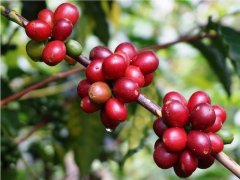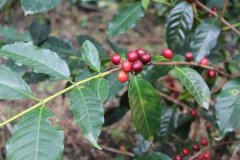What's the difference between handmade coffee and machine coffee? Demonstration of pure handmade coffee making process

Professional coffee knowledge exchange more coffee bean information please follow the coffee workshop (Wechat official account cafe_style)
The biggest challenge of drowsiness in the morning: it's best to have a cup of fresh coffee the first time you press a button, and it's more convenient to have a cup of coffee ready when you open your eyes. This is the current trend in device development and design. The most typical example is the programmable automatic drip coffee machine on the market. You only need to add water and coffee powder, and then set a wake-up time. When you enter the kitchen the next day, the coffee is already ready.
But there are also some flaws, such as coffee powder being oxidized while waiting to be made. Although this kind of machine is very practical in daily life, do you know it? Coffee seems simple, but it is also a complex chemical reaction. When it is exposed to the air for a long time, the roasted coffee beans lose a lot of ideal flavor (and absorb some unpopular flavors), and the process is accelerated by an increase in the surface area of contact with the air after grinding. so even if the coffee powder is only in the filter for one night, it will make the coffee taste stale.
At present, there are many capsule coffee machines on the market specifically to solve this problem. These machines make brewing coffee as simple as opening a can of beer. The process of making coffee by the capsule mechanism is to inject hot water into the coffee powder put in the plastic capsule. You don't have to calculate the amount of water and weigh the coffee. Moreover, excessive exposure to oxygen can be avoided in the process of transportation and storage, which slows down the oxidation. All you need to do when you wake up with a cup of coffee in the morning is press a button.
Another revolutionary method of extraction is a combination of ornamental, flavor and quality to promote coffee into a tasty drink, not just fuel for our brains. It is reminiscent of the ritualization of Turkish coffee (a ceremony designed to show guests enthusiasm and service) and the precision of picky espresso machines. This method can use strongly personalized cups, but it is very picky about the requirements of craftsmanship and methods. Some of me must have guessed that it was hand-made coffee.
It doesn't require specialized large equipment, or a French kettle, like espresso. A variety of utensils can be used to make hand coffee, and sharing is one of their few common features. From the perfect Chemex to the high-tech Aeropress, all the appliances work in much the same way: you need to prepare hot water and then pour the water into the coffee powder as they are named. Unlike the filter screen of the French kettle, most of the hand flushing uses filter paper, so the coffee is relatively clean and fresh. And hand-brewed coffee in order to ensure the ideal proportion and taste, be sure to weigh the weight of water and coffee powder.
Another way to make good coffee mediocre is the automatic drip filter, where the overheated water makes the coffee scorch, masking other flaws. There is no precise control over the use of coffee beans, so that the flavor brought by different producing areas, different elevations, and different treatments of coffee beans can not be shown. None of this matters if the coffee beans you buy are roasted like charcoal. All of this is aimed at freshly roasted boutique coffee, which shows that the diversity of flavor comes from the characteristics of their respective producing areas, and this information usually appears on the bags of coffee. You can trace back to the producing area, the farm, and so on in great detail.
It is not a simple question whether to choose a machine or do-it-yourself coffee. The machine is definitely a convenient choice, and you can get a good cup of coffee with just a button. But we can't appreciate the elegant process of making coffee, because they are all hidden in the plastic shell, and what we are facing is nothing but a cold machine. There is no communication and communication. But when we choose to brew coffee by hand, we get more than the coffee itself. For example, baristas will offer a lot of advice on what has changed recently and what caused it. Coffee shops usually provide their own baked beans, and each process is given more meaning. At the same time, some qualified coffee shop owners will personally go to the place of origin to communicate and learn with local farmers, so that coffee farmers can get more payment for their hard work, so that they can plant coffee more attentively.
Who makes better coffee, a man or a machine?
Of course, the answer depends on your definition of "good". Maintaining uniform quality may be a common standard in the coffee industry, everywhere: McDonald's, Starbucks, Waffle House and Tim Wendelboe, the world's most famous coffee company, are doing their best to provide customers with exactly the same coffee as expected, again and again.
Humans are good at many things, such as making objects with great taste and beauty, but staying consistent is not within this range. In fact, concerns about uneven quality and poor quality put the status of handmade coffee brewing in jeopardy-when there are many customers, baristas inevitably fail to take care of a detail, and the finished product is a bad cup of coffee. Because of this, in recent years, even some high-end and elaborate coffee shops have begun to consider switching to coffee makers altogether. A passion for quality has spawned thousands of dollars worth of hot water faucets (simply speaking, drinking fountains that can discharge a certain amount of water at a certain temperature in a certain amount of time) and a $15000 coffee maker that can make four cups of coffee at a time. Some coffee shops switch back to using manually operated large quantities of automatic coffee machines to ensure that the quality of the coffee will not be uneven.
Who makes better coffee, people or machines?
No wonder uniformity has become one of the biggest selling points of Briggo Coffee Haus. Briggo Coffee Haus is a new type of coffee vending machine in Texas in the past two years. Beneath the original wooden appearance is the fact that there is no cold, flesh-and-blood machine that makes coffee for you. In essence, every Briggo Coffee Haus vending machine is a large coffee robot connected to the cloud, and customers can use the application of Briggo to order their favorite coffee, then go to a physical machine to pick it up, or press a key directly on the physical machine screen and wait for a cup of coffee to be delivered. If, as expected, the same kind of coffee sold by each vending machine tastes the same, as the company spreads the machine around the world, you can drink the same taste everywhere.
And even the most advanced machines, using the most objective observations, can only be used to explain how a cup of coffee is made, not how it actually tastes. The reason, as pointed out in a paper in the peer-reviewed journal Food Science and Management (Food Science and Management), "the chemical composition of coffee flavor is so complex that it has not been thoroughly studied." You can't detect what you don't know, and coffee is estimated to contain at least thousands of aromatic compounds. And even if you can objectively measure the flavor and taste of a cup of coffee, it doesn't tell you how good that cup of coffee is. You don't know what coffee tastes like until you drink it, "Vincent Fedele said in an email. MoJoToGo, a brewing coffee iPhone app developed by Federer, has been well received in the coffee industry. In addition, there are times when "the numbers look right, but coffee often doesn't taste good".
Demonstration of pure handmade coffee making process
1. First get the preparation done and put some of the utensils you are about to make into one piece: coffee powder hand brewing pot glass coffee filter bag coffee spoon.
two。 Hang the coffee bag on the glass.
3. Then take about 10g of coffee powder.
4. Pour the ground coffee powder into the filter paper and gently pat flat.
5. Water injection: the water temperature is about 85 ℃, the novice hand flush should be uniform, there is no need to pursue any flushing method, as long as it is uniform, it will not taste bad. It is recommended to start water injection from the midpoint, and then draw a concentric circle along a direction to the periphery, but do not rush to the filter paper, and then draw a concentric circle until the center is so repeated. The current should remain stable, water injection can be divided into two or three times, and many players have disputes over the middle. As for the taste of any different aesthetics did not drink, so do not elaborate here, players can try their own.
6. Finish the extraction: finish the extraction, get a cup of black coffee, finish the water injection, remove the filter cup, and share our delicious coffee in the pot.
7. Enjoy the coffee: pour the coffee from the sharing pot into a warm coffee cup and you can enjoy a cup of warm and delicious coffee.
END
Important Notice :
前街咖啡 FrontStreet Coffee has moved to new addredd:
FrontStreet Coffee Address: 315,Donghua East Road,GuangZhou
Tel:020 38364473
- Prev

What's the difference between freshly ground coffee and handmade coffee? How to make a good cup of ground coffee at home?
Professional coffee knowledge exchange more coffee bean information Please follow the coffee workshop (Wechat official account cafe_style) freshly ground coffee, that is, before brewing, you can choose a hand grinder or an electric bean grinder, but it should be noted that the grinding thickness of handmade coffee is generally thicker than that made by coffee machine. When you start to get in touch
- Next

What are the hand-milled coffee tools suitable for household use? How to grind your own coffee at home?
Professional coffee knowledge exchange more coffee bean information Please follow the coffee workshop (Wechat official account cafe_style) We all like freshly ground coffee, but have been suffering from tools, brewing skills, time and other reasons leading to year-round can only drink instant coffee or buy a cup of made coffee in the coffee shop. I have talked to you about brewing skills before Qianjie coffee, which can be regarded as a solution.
Related
- Beginners will see the "Coffee pull flower" guide!
- What is the difference between ice blog purified milk and ordinary milk coffee?
- Why is the Philippines the largest producer of crops in Liberia?
- For coffee extraction, should the fine powder be retained?
- How does extracted espresso fill pressed powder? How much strength does it take to press the powder?
- How to make jasmine cold extract coffee? Is the jasmine + latte good?
- Will this little toy really make the coffee taste better? How does Lily Drip affect coffee extraction?
- Will the action of slapping the filter cup also affect coffee extraction?
- What's the difference between powder-to-water ratio and powder-to-liquid ratio?
- What is the Ethiopian local species? What does it have to do with Heirloom native species?

